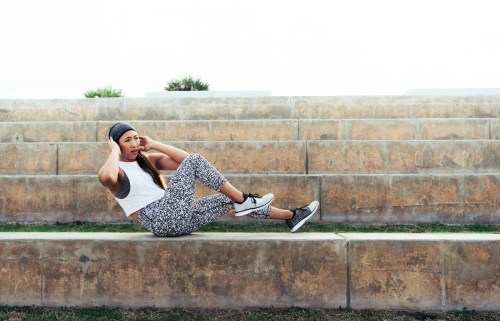Crunches and sit ups are the Dax Sheppard and Zach Braff of core exercises. Sure, sure, they’re both superstars, but I probably couldn’t tell the difference between which one was in Scrubs and which one just so happened to be the Armchair Expert. And the same kinda goes for the blockbuster abs-quaking exercises: I know which is which, but not so much the difference between what crunches and sit ups target, anyways.
The terms tend to be used interchangeably when most people talk about “ab exercises.” But actually, they’re two totally different things, which, I’m going to admit, is pretty confusing. “From the starting position, these exercises look very similar,” says Tone House Head Coach Joe Rodonis. “The main difference is the range of motion between the two. The crunch is more of an isolated movement on the core; only requiring you to raise your head and shoulder blades off the ground. While the sit up requires more range of motion and activates other stabilizing muscles.
With a sit up, you activate your hip flexors, for example, and will raise your torso off the ground.” Both moves work your core, but in different ways—crunches are made up of smaller movements to hit more targeted muscles, while sit ups require a full up-and-down range of motion. Here, Rodonis breaks things down even further to explain when to do which move.
Crunches
Don’t let the itty-bitty movements that crunches require fool you—these things mean business. “Crunches do a great job of isolating your abs, because, the range of motion is more concentrated,” Rodonis explains. For proper form:
1. Lie on your back in supine position with your knees bent and your feet flat on the floor.
2. Place your hands behind your head. Align your head with your spine, with slight flexion, move your chin towards your chest.
3. Contract your core muscles on the way up, towards your thighs, only raising your shoulder blades off the ground.
4. Flex your core and release tension on the way down to the starting position, keeping your neck relaxed.
Sit ups
“A sit up will also target the core, but requires more range of motion and activation of other stabilizing muscles,” says Rodonis. So instead of just getting the core, sit ups will get the muscles around it, too. To do ’em the right way:
1. Lie on your back in a supine position with your knees bent and your feet flat on the floor.
2. Place your hands behind your head. Aligning your head with your spine, with slight flexion, move your chin towards your chest.
3. Contract your core muscles, elevating your shoulder blades off the ground, and continue until your torso is off the ground and your chest is inches away from your thighs.
4. Slowly descend back down into your starting position.
As tempting as it may be to hustle through your core workout and get it over with as quickly as possible, slow and steady is key here. Rodonis notes that you want to feel the full flexion of each exercise in each direction—as in, don’t rush. With either move “quality over quantity” should be your mantra.
And when it comes to choosing which move to integrate into your routine, there’s no “better” or “worse” of the two per se. It really just comes down to personal preference, and what feels right for your body. “For those with lower back pain, the crunch may be a better option since it’s an isolated movement and keeps alignment in the spine. If you have tight hip flexors, you may also opt for the crunch,” says Rodonis. If neither feels quite right? Say hello to your good old friend the plank.
Once you’ve mastered the basic sit up, try the “suitcase” version, or add dumbbells to make it even more intense.
Sign Up for Our Daily Newsletter
Get all the latest in wellness, trends, food, fitness, beauty, and more delivered right to your inbox.
Got it, you've been added to our email list.











